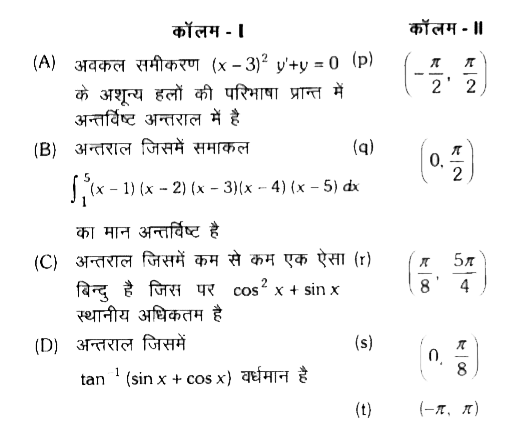f(x)=⎧⎪⎨⎪⎩ex0≤x≤12−ex−11<x≤2x−e2<x≤3 तथा g(x)=∫x0f(t)dt,x∈[1,3] तब g(x) होगा
x=1+ln2 पर स्थानीय उच्चिष्ठ तथा x=e पर निम्निष्ठ होगा
x=1 स्थानीय उच्चिष्ठ तथा x=2 पर स्थानीय निम्निष्ठ होगा
स्थानीय उच्चिष्ठ नहीं होगा
स्थानीय निम्निष्ठ नहीं होगा
The correct Answer is:A, B, C, D
Step by step video, text & image solution for f(x)={{:(e^(x),0lexle1),(2-e^(x-1),1ltxle2),(x-e,2ltxle3):} तथा g(x)=int_(0)^(x)f(t)dt,x in[1,3] तब g(x) होगा by Maths experts to help you in doubts & scoring excellent marks in Class 12 exams.
Updated on:21/07/2023Topper's Solved these Questions
- अवकलन तथा अवकलज के अनुप्रयोगBook:ERRORLESS HINDIChapter:अवकलन तथा अवकलज के अनुप्रयोगExercise:JEE Advanced (Reasoning thye questions)
Explore 26 Videos
- अवकलन तथा अवकलज के अनुप्रयोगBook:ERRORLESS HINDIChapter:अवकलन तथा अवकलज के अनुप्रयोगExercise:JEE Advanced (Comprehension type questions)
Explore 42 Videos
- अवकलन तथा अवकलज के अनुप्रयोगBook:ERRORLESS HINDIChapter:अवकलन तथा अवकलज के अनुप्रयोगExercise:EXERCISE
Explore 534 Videos
- अवकल समीकरण Book:ERRORLESS HINDIChapter:अवकल समीकरण Exercise:JEE Advanced ( Matrix Match type questions )
Explore 3 Videos
- केन्द्रीय प्रवृत्ति के मापBook:ERRORLESS HINDIChapter:केन्द्रीय प्रवृत्ति के मापExercise:Jee Advanced (Reasoning )
Explore 2 Videos
Similar Questions
माना f(x)=2+cosx , सभी वास्तविक x के लिए कथन - 1 : प्रत्येक वास्तविक t के लिए , [t,t+π] में एक बिंदु c का अस्तित्व इस प्रकार है कि f'(c)=0. क्योंकि
कथन -2 f(t)=f(t+2π) प्रत्येक वास्तविक t के लिए।
View Solutionमाना फलन f:(−∞,∞)→(−∞,∞),
f(x)=x2−ax+1x2+ax+1,0<a<2 द्वारा परिभाषित है
निम्न में से कौन सा सत्य है
View Solutionयदि y=acos−1x1+acos−1x,z=acos−1x, तो dydz=
View Solution
View Solutionकथन - 1 : प्रथम n सम धन पूर्णांकों का प्रसरण n2−14 है।
कथन - 2 : प्रथम n धन पूर्णाको का योगफल n(n+1)2 और प्रथम n धन पूर्णांको के वर्गों का योगफल n(n+1)(2n+1)6 है।
View SolutionLet f(x) be a derivable function satisfying f(x)=∫x0etsin(x−t)dtandg(x)=fx−f(x) Then the possible integers in the range of g(x) is_______
View SolutionA Function f(x) satisfies the relation f(x)=ex+∫10exf(t)dt. Then (a)f(0)<0 (b)f(x) is a decreasing function. (c)f(x) is an increasing function. (d)∫10f(x)dx>0
View SolutionSuppose f(x)andg(x) are two continuous functions defined for 0≤x≤1.Given, f(x)=∫10ex+1.f(t)dtandg(x)=∫10ex+1⋅g(t)dt+x The value of f(1) equals
View SolutionA continuous function f(x) satisfies the relation f(x)=e^(x)+int_(0)^(1)e^(x)f(t)dt then f(1)=
View SolutionIf f(x)=e^(g(x)) and g(x)=int_(2)^(x)(dt)/(1+t^(4)) then f'(2) is equal to
View SolutionIf f(x)=⎧⎪⎨⎪⎩x,0≤x≤12−ex−1,1<x≤2x−e,2<x≤3 and g'(x)=f(x),x∈[1,3], then
View SolutionIf ∫x0f(t)dt=ex−ae2x∫10f(t)e−tdt, then
View SolutionIff(x)=ex+∫10(ex+te−x)f(t)dt,findf(x).
View Solutionf(x)=⎧⎪⎨⎪⎩ex0≤x≤12−ex−11<x≤2x−e2<x≤3 तथा g(x)=∫x0f(t)dt,x∈[1,3] तब g(x) होगा
View SolutionIf f(x)=ex1+ex,I1=∫f(a)f(−a)xg{x(1−x)}dxandI2=∫f(a)f(−a)g{x(1−x)}dx, then I2I1 is :
View SolutionIf f(x)=⎧⎪⎨⎪⎩x,0≤x≤12−ex−1,1<x≤2x−e,2<x≤3 and g'(x)=f(x),x∈[1,3], then
View Solution

